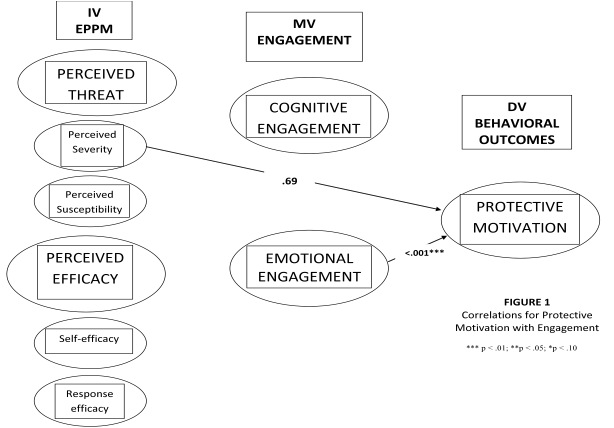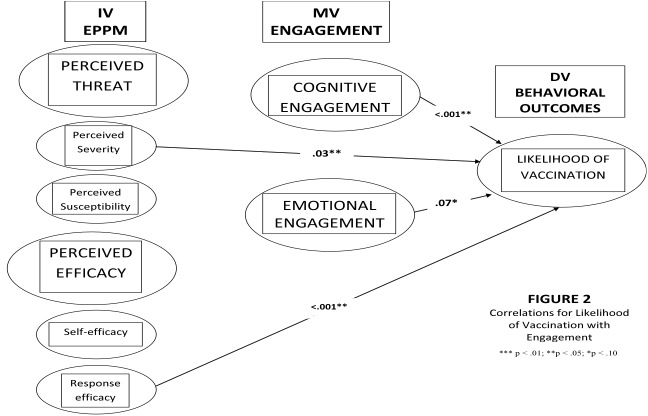Media Effects Research Lab - Research Archive
The mediating role of message engagement on h1n1
Student Researcher(s)
David DeIuliis (Masters Candidate);
Carolyn Donaldson (Masters Candidate);
Courtney Herring (Masters Candidate);
Omar Maglalang (Masters Candidate);
Faculty Supervisor
INTRODUCTION
The H1N1 flu pandemic is a timely health issue. In June 2009, the World Health Organization (WHO) declared that a new strain of swine-originated flu virus was responsible for the 2009 flu pandemic, with nearly 30,000 confirmed cases worldwide. As a way to combat the spread of disease, influenza vaccines have historically protected people from contracting the virus. The goal of this study was to examine behavioral outcomes such as vaccination intent after exposure to emotional health messages.
RESEARCH QUESTION / HYPOTHESES
RQ1: For adults, controlling for Internet health usage, perceived health issue knowledge, and previous exposure to the virus (H1N1), what is the relationship between fear appeals (fear-fear and fear-hope) and the level of engagement?
Hypothesis 1: A dual fear-hope message will result in higher engagement for respondents than a dual fear-fear message
RQ2: For adults, controlling for Internet health usage, perceived health issue knowledge, and previous exposure to the virus (H1N1), what is the relationship between fear appeals (fear-fear and fear-hope) and behavioral intention?
Hypothesis 2: A dual fear-hope message will result in higher behavioral intention than a dual fear-fear message
RQ3: For adults, controlling for message engagement, what is the relationship between perceived threat and behavioral outcomes?
RQ4: For adults, controlling for message engagement, what is the relationship between perceived efficacy and behavioral outcomes?
RQ5: For adults, controlling for message engagement, what is the relationship between severity and behavioral outcomes?
RQ6: For adults, controlling for message engagement, what is the relationship between susceptibility and behavioral outcomes?
RQ7: For adults, controlling for message engagement, what is the relationship between self-efficacy and behavioral outcomes?
RQ8: For adults, controlling for message engagement, what is the relationship between response efficacy and behavioral outcomes?
METHOD
The study was originally designed as a between-subjects experiment examining the dual process of fear-hope appeals and its relationship to engagement. Manipulation checks from the questionnaire found that fear and hope were not statistically significant. The study then moved on to analysis of correlational data with perceived threat and efficacy as independent variables, message engagement as a possible mediating variable, and behavioral outcomes as dependent variables. Using the Extended Parallel Process Model as a theoretical framework, the study manipulated health messages pertaining to the H1N1 virus and examined how fear appeals impact user cognitions to motivate health actions.
RESULTS
The results of these analyses indicated variability within the correlations that have illustrated protection motivation, defensive motivation, and likelihood of vaccination in the Extended Parallel Process Model.

Respondent perception of H1N1 as a threat was highly correlated with protection motivation, which includes self-protective behaviors and taking precautions against the H1N1 virus. The perceived severity of H1N1, as opposed to one’s feeling of susceptibility, is highly related to the outcome of protection from the threat. However, this relationship can be mediated by evoking a media message that is emotionally engaging.

Respondent perception of severity of the H1N1 pandemic and perception of an available and effective vaccine is related to likelihood of vaccination. Feelings of engagement can also predict vaccination intent.
Finally, respondent perception of severity, susceptibility, and feelings of ease about getting a vaccine are highly correlated with defensive motivation, which includes talking to others about the H1N1 pandemic. Respondent feelings of high emotional engagement after viewing a health message are also highly correlated with defensive motivation.
CONCLUSION
Overall, the results show that, with regard to the H1N1 virus threat, when individuals consider a threat severe, they are more likely to act in self-protective manner. The study also found that individuals rely on cognitive evaluations of the health message, all of which is consistent with other studies using the EPPM framework. The main findings from this study are consistent with other studies of the EPPM and conclude that when engagement is added to the EPPM model as a mediating variable, or even as a predictor of certain behavioral outcomes, individual behaviors regarding the particular health threat can be impacted. The new evidence of engagement as a mediating and predicting variable in the EPPM model advances this well-established measurement tool and arms public health communicators with valuable results for better behavioral outcomes.
For more details regarding the study contact
Dr. S. Shyam Sundar by e-mail at sss12@psu.edu or by telephone at (814) 865-2173

